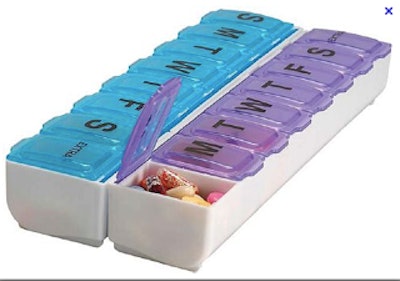
“Drugs don’t work in patients who don’t take them.” – C. Everett Koop, MD
That was the recurring theme at Pharmapack’s conference, where experts spoke about various trends they’re seeing when it comes to improving patient adherence. Beyond the obvious reasons to improve quality of life, patient adherence initiatives have the potential to reduce healthcare spending by billions in preventing unnecessary readmission and retreatment.
Electronic medication management aids
With so much thought going into pharmaceutical packaging design, we may forget that polypharmacy patients often remove their pills from primary packaging for use in multi-compartment compliance aides such as daily or weekly pill boxes. In older patients or those with severe health issues, it’s entirely possible that they need upwards of five medicines a day, at various times throughout the day.
So how can the industry target patient adherence when medications are removed from their instructions?
Researchers from the Pharmaceutical Care Research Group (PCRG) at the University of Basel, Switzerland, tested the effectiveness of a medication management aid with electronic monitoring that provides reminders, tracks patients’ dosage routines and provides feedback.
PhD candidate Samuel Allemann explained that at the end of a 14-day trial, half of the patients were ambiguous about their personal need for the device but they were able to provide valuable feedback on its size, alerts and other features. They also helped to identify target groups for the device: patients with time-sensitive medication regimens, patients with dementia, the visually impaired, and several patients living together to prevent accidental intake of the wrong medication.
The dispenser has shown benefits to patient outcomes, including a case in which a patient with irregular dosing habits turned on the reminders, and began taking medication on time. It also may help to take pressure off caregivers, some of whom are relatives or neighbors without healthcare backgrounds.
While we may not be ready for an electronic medication dispenser in every home just yet, researchers are working to determine how to improve and deploy the technology. As Allemann said, “It’s important that the medication arrives at the pharmacy in perfect condition, but we also have to think about how it is used by the patient.”
Device and experience design
Experts were clear that companies must examine the root causes to address the lack of adherence, keeping the end users in mind. Chris Evans, Vice President of Research & Innovation at West Pharmaceutical Services, said, “Cost is not the issue of adherence.” Even when medications are free, adherence rates are nowhere near 100%. So what are the various barriers to adherence? There are a lot of reasons—some patients are lazy, old-fashioned, or fear side effects—but according to Evans, the usability of drug delivery is a major factor, particularly for self-injected therapies. “If it’s hard to use, uncomfortable, painful, or scary, that has a big effect.”
Evans explained that drug delivery must encompass the Three C’s: confidence, convenience and comfort. “People do not want to be handcuffed to deliver the medication at a certain place or time. They need [to be properly educated] and need a high level of mobility and convenience.” Reducing dose frequency also increases compliance, as it reduces the number of interruptions in lifestyle.
West Pharmaceutical has partnered with Noble® and HealthPrize Technologies to target psychological barriers to adherence and gamify the process of prescription compliance.
Gamification
From miles per gallon to weight loss, many industries are taking cues from the gaming world, which has been more than proficient at engaging people for long periods of time.
At its core, patient adherence is about changing human behaviors. Turning something into a game with the possibility of reward is one way of removing the present bias and making a task—like taking medicine—more attractive.
John Ragland, Chief Product Officer at HealthPrize Technologies, has seen success with gamifying patient compliance. The company has combined patient education, rewards, and recognition into one platform with a dashboard that features:
-
The patient’s points, redeemable for health-related products, earned by adhering to prescriptions.
-
The prescription shown as a gauge for easy progress checks.
-
A leaderboard that gives a sense of status and community.
-
Daily health tips: small morsels of information that educate the patient about their medication.
“People don’t want to read ‘law speak,'” noted Ragland. By giving the leaflet information in bite-size pieces, there is significant patient engagement a few minutes at a time. Not many patients are willing to read an insert for 30 to 40 minutes, but by breaking it up and rewarding points for reading tips upon logging in, they’re motivated to educate themselves for longer overall periods of time. “Imagine a patient spending 30 to 40 minutes with your product’s information,” Ragland said. “It’s incredible.”
And for the cheaters out there, there is no way to confirm that oral doses are actually taken (injections can be confirmed). But a patient does not start accruing points until there is verification that a prescription is filled.
Patient-friendly packaging
The traditional pharmaceutical model had three main boxes to tick: safety, efficacy and quality. A company would discover a molecule that does something, put it through a long process and put it in a box. The molecule, the data and the FDA were at the forefront of everyone’s mind… the user and their experience were an afterthought.
“I can’t think of other products where the user doesn’t have a choice,” said Phill Marley, Chairman at the Healthcare Compliance Packaging Council (HCPC) Europe. Users research shoes and cars, and read reviews from peers. But for pharma products, there is little the user can do before purchasing.
“Why don’t we change it? Ask the patient what they want?” asked Marley. If you can’t make the experience of taking medicines pleasurable, he hopes companies at least make it neutral. Designing packaging for patients with patients means letting them provide feedback, even marking up the packaging.
He urged pharma companies to consider the patient journey, where a diagnosis may give way to shock and depression before acceptance. Marley said, “Packaging is often the only thing that connects patients once they’ve left the healthcare facility.” It’s crucial to make adherence as easy as possible during the beginning stages.
Marley noted that after three or four months, adherence may be as low as 20 to 30% even for serious conditions like cancers. But adherence leads to better patient outcomes, which equate to sales. “[Doctors, patients, companies] all want the same thing. It’s about doing the best we can with packaging.”























